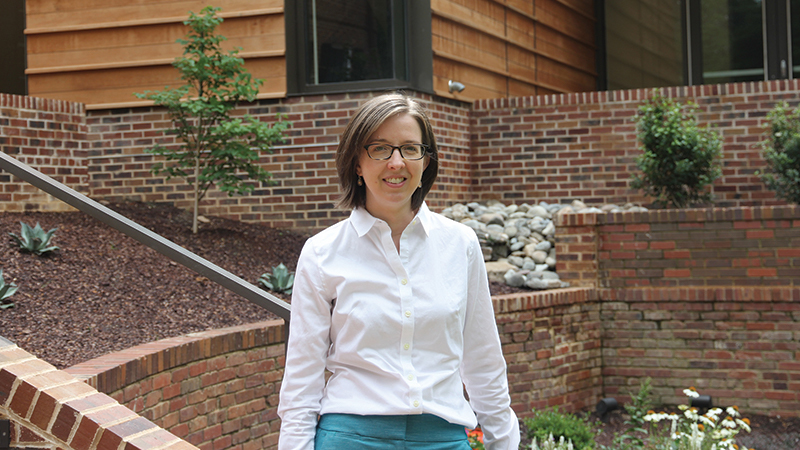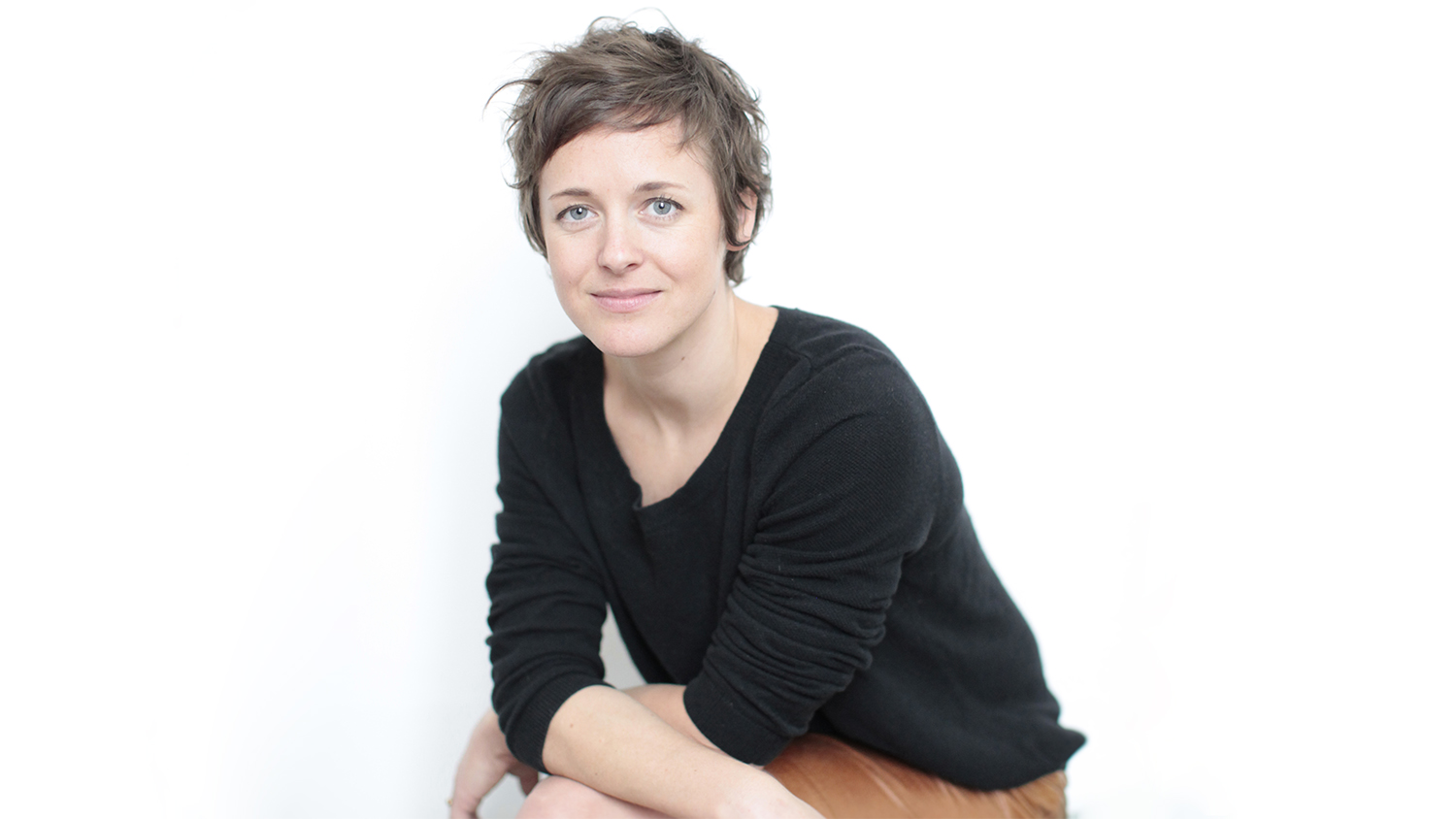Influenced by Design

Mary Hauser [BID ’01, MID ’04] made the most of her time while pursuing undergrad and graduate degrees at NC State. She took advantage of the many opportunities to gain exposure, learn new things, and meet others. “Having that exposure to the different areas of campus, whether it was the theater, music department, design, textiles, an internship—all of this was important to me, and still is. I would not trade these exposures or the time I spent on them for anything, because each of them has influenced where I am and how I can go back and interact with campus.”
“I would not trade these exposures or the time I spent on them for anything, because each of them has influenced where I am and how I can go back and interact with campus.”
Today, Hauser is the Associate Director & Registrar at the Gregg Museum of Art and Design, a position she loves that perfectly combines all her interests. The Gregg is part of the NC State Division of Academic & Student Affairs and was recently relocated to the site of the Historic Chancellor’s Residence at 1903 Hillsborough Street. This new location includes a major renovation and construction of more than 15,000 square feet. “The new location is going to have a lot of benefits. Being situated on a street that everyone knows the name of will be a help getting people here, and having our own face and front door will be another valuable change,” says Hauser. Prior to its renovation in 2015, the museum was housed in the Talley Student Union, which posed challenges of awareness, location, hours of operation, and space.
As an undergrad, Hauser was encouraged by Vince Foote (FIDSA and Professor Emeritus of Industrial Design) to explore swing studios in textiles with Susan Brandeis (Distinguished Professor Emeritus of Art + Design), which evolved into a flair for handbag design. After graduation, Hauser continued to take courses, and Brandeis championed her to consider graduate school as a way of exploring additional options. She considered costume design, teaching, working as an independent artist, or museum work. “I was able to do internships with museums that enabled me to try out different areas, like curatorial and registration,” she shares. One of those internships was offered through the Gregg. “An internship at the Textile Museum (in Washington, DC) solidified my interests, and I realized that was the direction I wanted to go in,” says Hauser.
All of Hauser’s exploration, experience, and commitment paid off when during her thesis show, two women she had worked with at the Textile Museum showed up. “They handed me a card that said, ‘We miss you, and congratulations; how would you like to come back to DC and work?’ It was pretty amazing, and I accepted the job. I always tell my interns now: Do internships. I can’t promise you a job, but it gets your foot into the door and exposes you to the culture, the work style, and the people, and if they don’t have a job there, they may know someone who does and can give you a reference.”
As a registrar, Hauser keeps track of the museum’s more than 35,000 objects, including items within textiles and clothing, ceramics, folk, and Native American art, photography, design and decorative arts, and outsider arts. “These items range in size from a button to our largest piece, which is the fountain that was outside of Talley.”
When asked what a registrar does, Hauser says, “I like to describe it as the curator knows what the objects are and knows their stories; a conservator does more interactive, fixing, or preparation of the object; but the registrar is the person who knows where and how the object is stored.” This includes the physical location of the objects down to the shelf they are on, whether a piece is owned, and the condition of each item. “In our institution, we try and keep track of everything within an arm span or within 50 objects—we break down the room in this hierarchy to get to a specific object. We should be able to find things within an hour.”
Every item in the collection is catalogued with a three-part numbering system that allows for meticulous tracking and identification. The system includes the year of the gift, the donation group or donor, and an object number that distinguishes whether it is single or multiple items, like a pair of shoes. These items then get catalogued in a digital database used by museums, another layer of identification including the artist’s name, the origin, the size, and where it is stored in the building. This may be the room, shelf number, or cabinet.
Another responsibility of a registrar is to understand the variable storage and environment needs of each piece for optimum preservation. “In a perfect world, we would have really diverse storage, but we actually have all unified storage,” says Hauser. Temperature and humidity are constantly monitored. “One of the biggest threats to a collection is when a system fails and you get immediate temperature change,” she explains. To diminish this risk, objects are buffered, or stored in boxes and wrapped in tissue or plastic, which protects them from mold, dust, and temperature changes.
The collection is vast and diverse. Roughly 85 percent of it can be researched online. With advance notice, the public can gain access to collections or items. “People come to look at our objects for different reasons,” Hauser says. “There is so much more when you see an object in person that you can’t get online. It is totally different in person.”
As a public institution, the Gregg offers educational opportunities, internships, exhibitions, film screenings, lectures, a library of more than 3,000 books related to objects within the collection, and collaboration with university faculty to enrich courses through visits, tactile experiences, and informative lessons. “We cannot show more than one or two percent of our collection at once,” Hauser notes. “We collect to help the University, whether through classes or cultural opportunities. It is a less well-known way of working as a museum.”
Hauser offers a unique perspective when working with faculty who want to incorporate objects from the collection into their courses. “We have had designers designing houses come in to see historic examples to inspire new work. We have some clothing construction classes that come to look at how garments are made.” Students have been able to learn from some of the textile collections how garment construction was done in the past. By learning from the technology of the past, they can focus on creativity.
As a student, Hauser took the Pre-Industrial World Textile seminar by Brandeis, which was an influential and hands-on introduction to the world of textiles and was cultivated for more than two decades with the Gregg. For the past few years, Hauser has been able to collaborate with Brandeis and provide valuable insight on items within the collection that can be included in the seminar. “My understanding of the collection has made this class richer,” Hauser says. “[Brandeis] brought her experience as a teacher and textile designer, and I was able to bring my experience as a student and museum professional to create a pretty awesome opportunity.”
Nearly all of the Gregg’s 35,000 objects are donated. Hauser says fewer than one percent of the collection is purchased. “Usually [collection items are] purchased by Friends of the Gregg, and then they donate them.” Anyone can financially support or donate objects to the museum’s collection.
Hauser has a hard time choosing her favorite part of the job. “I love organizing, but I like to be able to do that so that I can find the piece that will light someone’s eyes up—whether in an exhibition, a class, or a research visit, or through an internship—to show them something they have never seen before or that will change the way they think about themselves, the world, or their work.”
She reaffirms the Gregg’s commitment to working for all students on campus. The collections within the Gregg include items that enhance the interests and experience of a broad spectrum of individuals. “All of these things wrap together to make us who we are, and we are intent on being for the entire university and offering things that make all students from any background ask questions or think about their world differently.”
“It is neat to be in a space where so much of what Raleigh is becoming and the Triangle is becoming is influenced by a place I feel a connection to—the College of Design,” she says.
- Categories:


